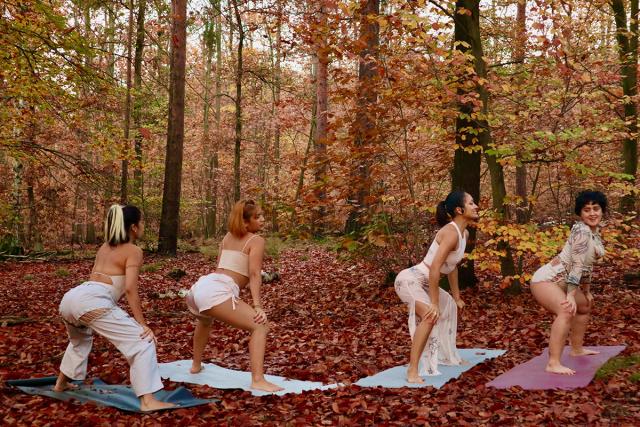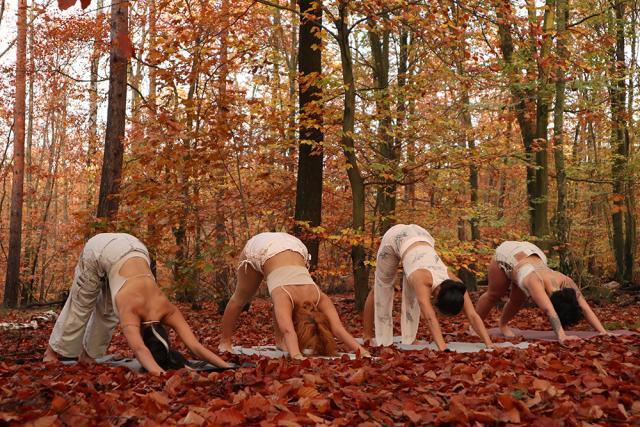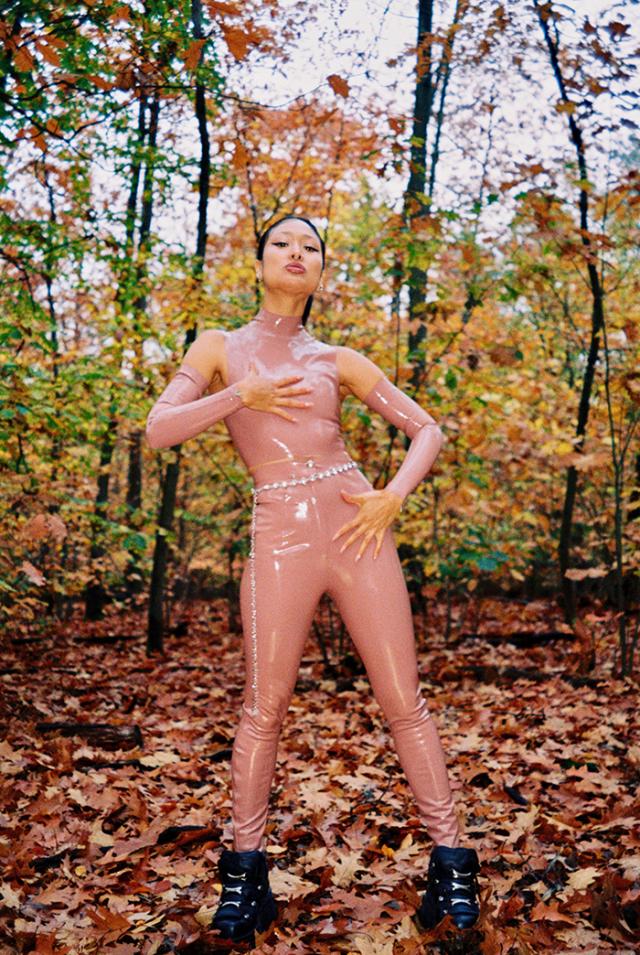Inhabiting the In-Between: Yoggaton, Migration and Body Emancipation
I notice more and more the thousand influences that inhabit my body and shape my corporality all the time. Every experience, every person or decision I encountered left something in me and so, I recognize my identity as ch’ixi1, mestiza, shaped by different internal and external processes and dialogues.
I came to encounter Yoggaton thanks to reflections about what kind of movements and body practices were already part of me and that were socially understood as contradictory to one another. Yoggaton is the intersection of yoga®gaeton. It is Spiritual and Pleasure Activism and intense perreo coming together to decolonize bodies and challenge binaries. This movement practice works at/with/from physical, emotional, mental, spiritual, and decolonial levels.
During my Master's studies, I had space for self-reflecting on my artistic work and the practices that informed it. I realized I was working a lot with the connection of so-called opposites like civilized-savage, good-bad, whore-saint, as starting points for considering binary thinking as colonial heritage. I had that ‘a flor de piel’ and one day, as I came back from a party, I just started doing “yoga to reggaeton” in my room. I wanted to stretch and still had the party mood and doing yoga to reggaeton came so naturally to me. Afterwards, I started sharing it with friends and kept on opening dialogues with this physical experience, and the philosophies and references it connects to, from an intersectional point of view.
Sensuality and Perreo as Tools for Healing
During the practice we make our pelvic floors vibrate a lot. The reggaeton bass immediately moves, ‘calls’ the hips, the culo and the pelvic floor, where the first and second energy points or Chakras are allocated. The energy of the first Chakra connects us to the roots, to the sense of belonging and the ancestral inheritance, and the second to the emotional body, sensuality, and creativity. Shaking these energy points awakens them and brings attention to the energies related to them. In my experience, there is something about perreo, about bootie shaking that is quite primal, there is an immediate response of satisfaction that does not need to be rationalized in order to be valid. Talking about awakening energies, the work with the pelvic floor also awakens the sexual energy. I understand this energy as a powerful creative one that deserves to be distributed throughout the body. However, it is important to know how to connect the awakening of this energy with the work of breathing and observation in order to integrate it in a way that is as beneficial as possible and does not end up blocking us instead of opening us.
Perrear/shaking the ass and hips is really satisfactory to me. I drop my jaw, relax myself, and follow the beats. The deep vibrations in the pelvic floor are not just pleasurable but regenerative, they help move the energy accumulated there, allowing restoration at a cellular level. As mentioned before, the first and second chakras are related to our roots and ancestral inheritance and vibrating them really puts us in connection to the emotions and sensations that characterize them: security, home, creativity, self-confidence. Beyond the hardships we might have when it comes to these topics, there is an opportunity to connect and, when given the chance, heal our relationship to them.
Movement and breathwork allows space between us and our ideas, emotions, sensations, and to me that is precisely the work of healing: continuing to be responsive to life in any way we find best; keeping ourselves in motion, meaning being able to keep on developing our paths; knowing that wherever we come from, our roots are secure and we can keep on developing ourselves.
Connecting the Culo and the South of the Body to the Pachamama
One of the most important intentions of Yoggaton is to connect the pelvic floor and the lower extremities to the ground, to the earth in order to understand the connection to Mother Earth, Pachamama, at a body level, to have the experience of feeling this belonging to the earth. Pachamama is where we come from and where all beings return to. In Andean thinking, the universe is an integral set of relationships, within an order of correspondence and complementarity. This cosmic relationality is something sacred that reveals the divine (Estermann, 2006). So of course if we feel this connection, it is easier to understand the divinity of Pachamama and the divinity in us because we come from it.
I was raised in a Catholic household, went to Catholic school, and was constantly reminded that the body was associated with sin, so unlearning that and remembering that my body and everyone else’s bodies are divine and deserving defies a very ingrained colonial condition. Pleasure also defies that Catholic-colonial conditioning that proclaims suffering is the way to get to heaven. I think the idea of heaven and hell is the epitome of binary thinking from which other categories of control emerge: good-bad, whore-saint, etc. Catholic logic seeks to deny the shadow of the humanity or 'hell' to tend to the good and enlightened but departing from a double standard where to get closer to God you have to be homophobic, for example.
Decolonizing and Reconnecting to our Bodies and Communities through Pleasure
Since I started developing and practicing Yoggaton, it has given me so much pleasure that of course I want to offer space for others to connect to their own pleasure and personal power, especially for those people with a similar colonial experience. Pleasure is powerful and transformative. It really changes body language, posture, one‘s way of walking and talking, and that transforms into positive sensations, thoughts, feelings, and actions. adrienne maree brown, author of Pleasure Activism, refers to it as the work we do to reclaim our whole, happy and satisfiable selves from the impacts, delusions and limitations of oppression and/or supremacy. (brown, 2019)
Therefore, I see healing as something collective. In the Yoggaton classes, we mainly work in a circle and with closed eyes, to create a sense of collectiveness and at the same time to be conscious of the movement coming from within. Healing can get very ugly and tiring at times, so it is good to be creative, to use every tool we have around to help us go through it. I find dance, music, and perreo to be amazing ways of doing spiritual work. I want it to be fun and deep and fabulous because there is already too much suffering, overthinking, unsolved issues, and new issues arising everyday. My proposal is to give ourselves time to connect to our divine bodies.
Busco en tu Infinito las Raíces
Migrating is inhabiting the in-between in so many ways that maybe it is best way to understand with the body what in-between means. For Gloria Anzaldúa, this liminal space is called Nepantla, nahuátl word that means world between worlds. Since Yoggaton comes from many different places that converge in my body, I felt the invitation to be a nepantlera, the one living in this world between worlds, and to start weaving with the given materials. In the action of weaving a new fabric where different practices and experiences coexist, I find not only coherence but celebration of that Mundo entre Mundos.
Regarding this, I think of the origin of the word yoga: Yuj, a Sanskrit word that means ‘to unite.’ Being in unity with oneself and being in unity with the world. I feel that westernized yoga sells the idea of a forever positive mind and a normative body that practices asana yoga. Susanna Barkataki is a yoga teacher invested in decolonizing this practice and from whom I am currently having the pleasure to learn. As she often says at class, for Patanjali the doubt, the not-so-easy-to-deal-with feelings and emotions are the yoga too, and from the acknowledgement of that common terrain where the lights and shadows are, the recognition of ourselves as complete persons, persons who have these lights and shadows, will be possible.
Vamos a Re-Conectarnos
Do you feel like wanting to be more in your body? Dance, sing, move in whatever way you feel more comfortable with, alone or with friends or a group of people at a class. Just move and make your movement more conscious every time. Be playful, ask yourself what your body wants to wear today, how it wants to move today, what element is moving you today? And of course if perrear, breathwork and yoga es lo tuyo, I invite you to practice Yoggaton.
Footnotes
1. Ch’ixi: Aymara word that means mixture of colors. For Silvia Rivera Cusicanqui, Bolivian sociologist, the ch’ixi identity is a mixed identity.
Bibliography
Barkataki, Susanna. Embrace Yoga’s Roots. Courageous ways to deepen your yoga practice. Ignite Yoga & Wellness Institute. 2020
brown, adrienne maree. Pleasure Activism: The Politics of Feeling Good. AK Press 2019 p.13
Estermann, Josef. Filosofia Andina. La sabiduría Indigena para un mundo nuevo. 2 ed. La Paz ISEAT 2006. p. 285






